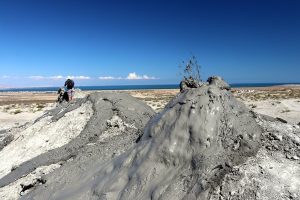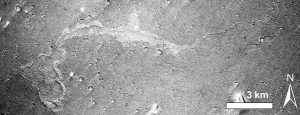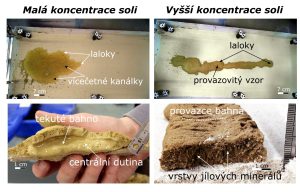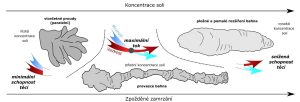In the northern lowlands of Mars, there are thousands of small cones that scientists believe were formed tens to hundreds of millions of years ago by mud flowing from underground. Mud on the surface of Mars behaves very differently to what we see on Earth due to the extremely low atmospheric pressure, which makes liquid water unstable. Until now, it has been unclear how the presence of various salts and their amounts change the properties of mud in the Martian environment. An international team of scientists led by Ondřej Krýza from the Geophysical Institute of the Czech Academy of Sciences focused on investigating these processes in experiments — now published in the journal, Communications: Earth & Environment.
Due to the extremely low atmospheric pressure (less than 1% that on Earth), liquid water is not found on the surface of the red planet. Therefore, it is difficult to predict how mud, a mixture of water and fine-grained rock fragments, would behave. These are Martian equivalents of the mud volcanoes seen on Earth. To investigate how salts and their amounts affect mud flow, we used a unique low-pressure chamber at the Open University in the UK.
“Our experiments help explain the paradox of how mud volcanoes exist on the surface of Mars when conditions do not generally allow mud to remain in a liquid state. While on the surface of Earth, mixing salts into the mud does not fundamentally change the appearance of a mud volcano, it will be different on Mars,” explains Ondřej Krýza, the lead author of the study. He adds, “We assumed that with increasing salt content, the mud mixtures would be able to flow further because the mixture would remain liquid longer. But we were surprised that the appearance of the mud flows also changed significantly with the change in salt and its concentration, and the reach of the flows may even decrease with a higher salt content.”
The results of this study suggest that on Mars different salts and their concentrations will lead to the formation of mud flows that will differ significantly from each other. Their shapes may resemble long strands of lava, wide pools, or short and fragmented lobes. The colour of the surface also changes, which may help in identifying mud structures from satellite observations.
“Salts can significantly change not only the temperature at which water in the mud begins to boil and freeze but also its flow properties. The relationship between these factors is completely different at low pressure than in terrestrial conditions,” adds Věra Pěnkavová from the Institute of Chemical Processes of the Czech Academy of Sciences, a co-author of the study.
Salts are increasingly being detected by remote sensing not only on the surface of Mars but also on other bodies in the Solar System such as the dwarf planet, Ceres, where liquid water probably reached the surface in the past. Here, as well as on the large icy moons of Jupiter and Saturn, it is assumed that a mixture of water, ammonia, hydrocarbons, and salts flowed to the surface in a process known as ‘cryo-volcanism’. These could be an important host for potential microbial life forms. Hence, understanding the fundamentals of how salt-rich mixtures spread may play a crucial role in the search for life in the Solar System.
More info: Ondřej Krýza, Ph.D. – first author
Věra Pěnkavová, Ph.D. – co-author
Link to the original article:
Ondřej Krýza, Petr Brož, Mark Fox-Powell, Věra Pěnkavová et al.:
Small amounts of dissolved salt increases the mobility of mud flows on Mars and other extra-terrestrial bodies
Associated movie:
Related images:

Figure 1: One of the smaller cones of Dashgil mud volcano in Azerbaijan. (PHOTO: Petr Brož)

Figure 2: Possible mud flow on Martian surface. Captured from Brož et al. (2019).

Figure 3: A view of the low-pressure chamber at the Open University (UK) where the mud experiments were conducted. The chamber makes it possible to reduce the atmospheric pressure to values prevailing on the surface of Mars in a few minutes. PHOTO: Petr Brož

Figure 4: An example of the shape of mud flows with differing salt concentrations (specifically, MgSO4 at concentrations of 0.5% and 10%). With higher salt content, the reach of the flow increases, but the flow pattern and colour also change.

Figure 5: Explanation of the changing behaviour of mud with increasing salt content. If the concentration is low, the mud freezes more easily. If the salt content is higher, the viscosity of the mud and its freezing point decrease. However, if the mud is “saturated” with salt, its viscosity increases. Therefore, the mud flows less easily, but freezes significantly later.

Ondřej Krýza (PHOTO: Miroslava Macháčková)

